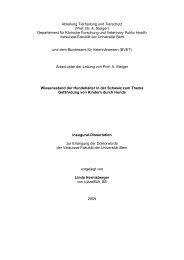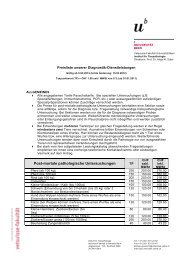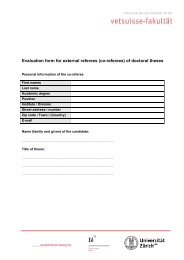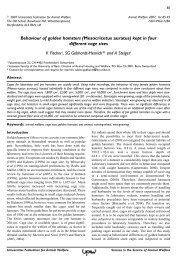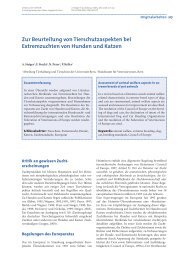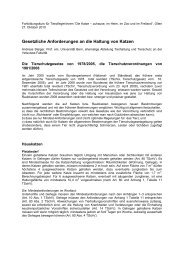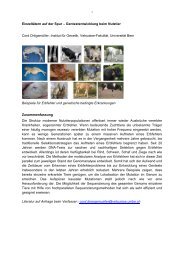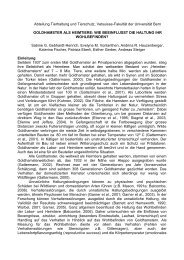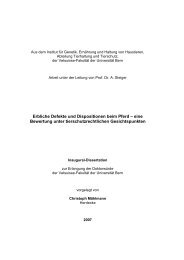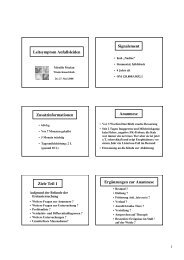Behaviour of golden hamsters (Mesocricetus auratus) - Vetsuisse ...
Behaviour of golden hamsters (Mesocricetus auratus) - Vetsuisse ...
Behaviour of golden hamsters (Mesocricetus auratus) - Vetsuisse ...
You also want an ePaper? Increase the reach of your titles
YUMPU automatically turns print PDFs into web optimized ePapers that Google loves.
directed exploration, which, after a steady ineffectiveness, no longer contributed toexploration.Wiedenmayer (1995) stated that 12 seconds was the critical minimum time forstereotypic digging in gerbils. Normal digging was never performed for the sameamount <strong>of</strong> time. Similarly, we stated a total duration <strong>of</strong> wire gnawing <strong>of</strong> less than 1 %<strong>of</strong> total observation time as non-stereotypic, which is less than 54 seconds over anobservation time <strong>of</strong> 90 minutes. Some <strong>hamsters</strong> were seen to bite into the wireshortly while passing the wire but then immediately walked on.As shown in the results, <strong>hamsters</strong> clearly gnawed longer and more frequentlyon the wire than on other things. This was not expected, since it is not a naturalbehaviour <strong>of</strong> <strong>hamsters</strong>. Gnawing on the cardboard tube, on twigs or on the woodenhouse serves a purpose, since it is helpful for abrasion and cleaning <strong>of</strong> the teeth.Some <strong>hamsters</strong> fractionalised the cardboard tube and used it as nest material. Wiregnawing though seemed to be ineffective and senseless. It could not be prevented byproviding natural material to chew on, so wire gnawing and gnawing at objectspresumably had a different cause and / or function. Wire gnawing might be anattempt to escape from the cage (similarly in mice, Würbel et al. 1998a, 1998b).The results from this study indicate that housing in big cages improved thewelfare <strong>of</strong> the <strong>hamsters</strong> because it resulted in less stereotypic wire gnawing. Thebiggest cage with a size <strong>of</strong> 10,000 cm 2 was the one with the shortest wire gnawingduration and the lowest frequency (bouts). Duration and frequency <strong>of</strong> wire gnawing in10,000 cm 2 was half <strong>of</strong> the duration and frequency in 5,000 cm 2 cages. If this is takeninto account, the required minimum <strong>of</strong> the Swiss Animal Protection (SAP) <strong>of</strong> 5,000cm 2 seems still to be too small. However, although <strong>hamsters</strong> in small cages showedmore wire gnawing than <strong>hamsters</strong> housed in bigger cages, wire gnawing occurred in22



